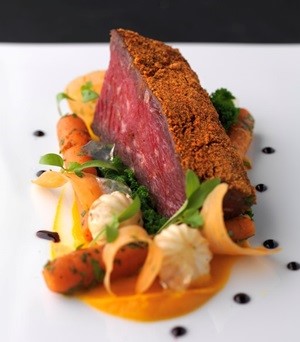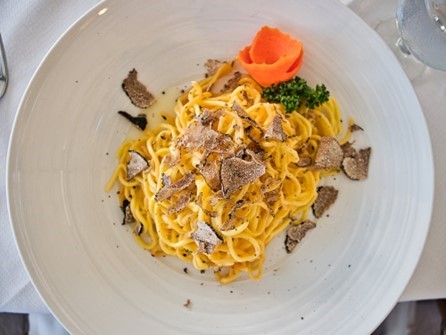How can red meat and dairy capitalise on menu trends
Tuesday, 21 May 2024
The foodservice market is in value growth of +15% (Kantar, 52 w/e 17th March 2024).
This is not only due to inflation, but also a result of the frequency of trips out-of-home (OOH) increasing by 13%.While this positive trend shows a clear sign that consumers are returning to old routines post-COVID, the cost-of-living crisis remains a challenge for many.
Eating out has become more expensive, with inflation in restaurants, cafes, fast food and canteens high at +5.8% greater than last year (ONS). In the last 12 weeks although shoppers have been eating out more often, they have been spending less per trip.
Many of the menu trends we highlighted in 2023 are still relevant, but how can we build on these in 2024? And what opportunities are there on menus to encourage red meat and dairy consumption?
1. World cuisines and British dishes
Capitalise on creative world cuisines, high quality nostalgic British dishes or a mix of the two.
Many consumers eat out to try something new, different, and full of flavour. Therefore, utilising trending international cuisines provides a great opportunity to gain space and stand out on menu.
Established cuisines such as Japanese, Thai and Mediterranean remain important in market, but according to Lumina Intelligence cuisines including Filipino, Cuban, Austrian, Caribbean, Korean and African are emerging.
We’ve delved into two of these emerging cuisines to highlight some opportunities for the red meat sector.
Firstly, Korean with BBQ’s, Bibimbap bowls and hot pots, and marinated pork and beef are used in many dishes. Mainstream operator Wagamama have jumped on the trend by adding a Korean inspired beef hot pot to the menu.
Secondly, West African “suya”, a traditional grilled spiced meat skewer, popular with beef, has seen a peak in Google searches in the last year.
London based restaurant Akoko specialises in the cuisine, featuring bold and innovative flavour combinations with proteins including lamb.
According to Mintel, 2 in 5 UK foodservice consumers would be interested in ordering Korean cuisines, and the same for African cuisines from restaurants, takeaways or pubs in the future (Kantar Profiles/Mintel, Menu Trends – UK, February 2024).

However, as mentioned in last year’s menu trends, there is still one cuisine that will never grow old and that is British. 53% of UK foodservice consumers have ordered British food OOH in the past month according to Mintel (Kantar Profiles/Mintel, Menu Trends – UK, February 2024), with familiarity and comfort being drivers.
It is therefore no surprise that traditional British meals feature as important protein dishes OOH, with familiar favourites like shepherd’s pie and steak performing well. Nevertheless, to ensure these dishes retain their popularity and stand out on menu, we must utilise and communicate their high quality ingredients and sourcing credentials (see insight 3), as well as exploring innovative recipes and presentation.
The merging of British foods, formats, and dishes with other global or world cuisines, or ‘British Fusion’ is also popular. 35% of consumers, according to Bidfood, state they find British Fusion appealing, because it is a way to try new flavours in a format they are familiar with (Bidfood, British Fusion: A British food trend in 2024).
British dishes which lend themselves to this are pies, roast dinners, and English breakfasts. A popular example being the Bombay-inspired restaurant group, Dishoom, reinventing the bacon sandwich by serving it with a tomato chilli jam on a naan roll.
2. Innovate
Innovate dishes on the menu with indulgence in mind and communicate the flavour experience via menu descriptions.
The desire to have a treat is a leading reason why UK consumers eat OOH (Lumina Intelligence, UK Menu & Food Trends Report, 2023). They want a special culinary experience which they don’t typically get at home, and they want to indulge. Therefore, operators need to constantly think of new ways to satisfy this need.
Focusing on flavour is a good way of doing this. According to KerryDigest, flavours to watch out for are high impact tastes with strong regional associations, such as chilli varieties (jalapeno, chipotle, piri-piri), citrus, coriander, soya sauce, kimchi, cheese varieties (parmesan, cheddar, feta), barbecue (US regional, Korean, Brazilian) and herb and spice blends (togarashi, za’atar, cajun) (KerryDigest, The 2024 Taste Trends, 4th January 2024).
Flavour can also be enhanced by the preparation or cooking method. Therefore, pairing meat and dairy with unique herbs, spices and sauces, and communicating this via the menu descriptors, will ensure a dish stands out.

This trend is applicable to all channels in the market. In a post-COVID world, commuting to an office and grabbing lunch out is no longer an everyday occurrence, meaning food-to-go establishments have a big opportunity with treating.
Grocery multiples, fast food establishments and coffee shops need to develop offerings and menus with affordable treats, limited edition items and seasonal options to catch consumer attention.
This is translating in market among the mainstream operators via indulgent dairy and meat offerings, such as loaded nachos, innovative and premium toastie options and flavoured or spiced hot drinks.
We also see specialised new openings tapping into the lunchtime indulgence trend, such as Dom’s Subs, which is a New York style deli-sandwich concept focusing on super-sized subs with high quality ingredients such as roasted, smoked and cured meats and cheese varieties.
3. Sourcing
Talk about sourcing credentials on the menu to tap into quality-led consumers.
From consumer research we undertook last year, we identified the importance of communicating quality to drive enjoyment when eating out.
According to Lumina Intelligence, 73% of consumers are happy to pay more for higher quality, but quality expectations are growing due to an increasing awareness and interest in the food we are eating.
Therefore, operators can boost quality credentials through introducing more premium ingredients on menus (e.g. Prezzo and Ask Italian have introduced dishes which feature truffle), or by focusing on the provenance of ingredients.
Partnering with British, or local, farmers and producers to source fresh, high-quality ingredients and then showcasing this on menus was proven via our research to improve perceptions and reputation of the red meat industry.
For example, The Pig Group, which has built a brand story based on its sourcing commitment within a 25-mile radius. Our research for red meat also found that accreditations, such as Red Tractor, and descriptors such as outdoor bred and grass-fed, act as quality cues for consumers on menu and are therefore beneficial.
Sustainability transparency is growing in importance too, according to Lumina Intelligence, with 63% of consumers claiming to be sustainably conscious.
Strategic initiatives are coming through in market around carbon footprint mitigation and waste reduction. However, keeping sustainability messaging at an operator level is likely best, as our research found sustainability messaging specific to red meat was not top of mind when selecting a dish.

4. Re-engage lost consumers
Re-engage lost consumers by thinking about individual needs when considering menu offerings – value, customisation, families and socialising.
Despite the foodservice market being in value growth, the number of consumers who use it is down year-on-year. And as the average consumer typically has 234 OOH food and drink experiences a year (Kantar, 52 w/e 17th March 2024), even a slight drop in the number of users has a huge impact.
Therefore, operators need to consider ways to re-engage lost consumers.
As mentioned earlier, value scrutiny is forefront for many. Operators are responding to value needs through targeted promotions, rewards platforms and meal deals to encourage spend and boost value credentials.
While you may expect this to just be the case in mainstream establishments, premium restaurants are also understanding its importance. The Ivy Collection has launched a rewards app and Hawksmoor have a special offer on Mondays where you ‘bring your own booze’ to save money.
Last year’s trend of offering more customisable options has accelerated. It allows for a more personalised consumer experience that enables dining occasions to be tailored to consumers specific preferences and needs, for example, a healthier dish, or a more premium dish.
Examples include Marugame Udon who have introduced a meal deal which allows you to select a small, medium or large portion, and Greggs which allows you to tailor your pizza toppings when ordering online.
Families are a large group that operators do not want to lose out on and options for children are important to gain footfall from this demographic. Pret A Manger launched its first children’s menu this year called ‘Little Pret Stars’, which features kid size sandwiches, toasties and snack pots.
Socialising is a key need when eating out of home and tailoring menus to create options to share food is becoming increasingly important.
Sharing dishes are gaining space on menus, through offerings such as charcuterie boards, tacos and sliders. However, in the last year Lumina Intelligence has seen sharing expand to side dishes and desserts.
Bill’s are launching a dynamite doughnut dessert for 6+ people, which is a doughnut tower, drizzled with chocolate and dulce de leche sauces. Desserts provide a great opportunity for the dairy category.

Sign up to receive the latest information from AHDB.
While AHDB seeks to ensure that the information contained on this webpage is accurate at the time of publication, no warranty is given in respect of the information and data provided. You are responsible for how you use the information. To the maximum extent permitted by law, AHDB accepts no liability for loss, damage or injury howsoever caused or suffered (including that caused by negligence) directly or indirectly in relation to the information or data provided in this publication.
All intellectual property rights in the information and data on this webpage belong to or are licensed by AHDB. You are authorised to use such information for your internal business purposes only and you must not provide this information to any other third parties, including further publication of the information, or for commercial gain in any way whatsoever without the prior written permission of AHDB for each third party disclosure, publication or commercial arrangement. For more information, please see our Terms of Use and Privacy Notice or contact the Director of Corporate Affairs at info@ahdb.org.uk © Agriculture and Horticulture Development Board. All rights reserved.

